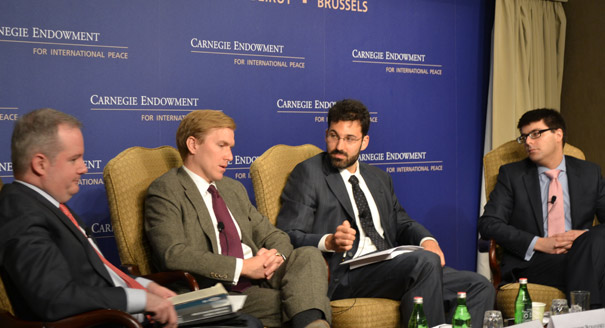Registration
You will receive an email confirming your registration.
The Obama administration has made strategic stability the centerpiece of its nuclear relations with Russia and China and pledged to formulate its nuclear policy around the concept. Yet there exist major disagreements on the meaning of strategic stability and whether it is a sound basis for policy. In the recently published edited volume Strategic Stability: Contending Interpretations, experts argue for and against the value of the concept and for differing interpretations of what it should mean. Carnegie’s James M. Acton and Matthew Rojansky, who both have chapters in the volume, discussed the book’s key conclusions and insights with author and editor Elbridge Colby, research analyst at the Center for Naval Analyses. Thomas Moore, deputy director of the Proliferation Prevention Program at the Center for Strategic and International Studies, moderated.
Discussion Highlights
- Legitimate Nuclear Use: Colby argued against definitions of strategic stability that singularly emphasize limiting the incentives for the use nuclear weapons. He posited that a narrow focus on reducing the risk of nuclear use can undermine the goal of deterring major conventional war. Under his preferred definition, a stable relationship is one in which a state would only use nuclear weapons to “vindicate” its vital interests. This definition, he argued, would preserve incentives for legitimate nuclear use as a response to threats against vital state interests while simultaneously undermining illegitimate and destabilizing incentives to use nuclear weapons.
- The Great Power Gambit: Rojansky noted that nuclear weapons disproportionately support Moscow’s great-power status. Consequently, Russia is wary of any strategic move that might undermine the importance of its nuclear arsenal. Rojansky argued that, in Russia's view, strategic stability requires that other global powers avoid steps that may jeopardize the centrality and efficacy of Russia’s nuclear arsenal. Rojansky stressed that policymakers should think critically about how a move away from parity-based force structures will impact Russian perceptions of their strategic advantages and disadvantages.
- Force Posture: Acton argued that a stable relationship should be defined as one in which neither state perceives an incentive to change its force posture (including the use of nuclear weapons) out of concern that in a crisis its adversary might use nuclear weapons first. Acton recognized that although strategic stability is an important goal, it is not the only goal and that other factors—including deterrence effectiveness—must be considered.
- Strategic Stability versus Deterrence: Acton and Colby debated the latter’s recommendation that the United States create a lower yield (“primary only”) version of its W76 warhead for Trident D5 ballistic missiles. Acton argued this change might marginally increase deterrence effectiveness but could have a significant adverse impact on strategic stability. He further argued that this trade-off exemplifies why it is useful to treat strategic stability and deterrence effectiveness as analytically separate concepts. Colby disagreed that his recommendation would negatively impact strategic stability, arguing that Russia and China would be unlikely to interpret the lower yield W76 as a first-strike weapon.
- Budget Constraints: Acton and Colby also discussed the implications of possible future Pentagon budget cuts due to the current constrained fiscal environment. Acton emphasized the critical importance of engaging in a debate about which systems are the most strategically valuable for the United States. He argued that although nuclear bombers were the easiest leg of the triad to cut, they were more valuable than ICBMs. Colby emphasized the importance of the U.S. nuclear triad and argued that the United States should cut from the ground forces instead of nuclear capabilities.
- Arms Control: Rojansky pointed out that arms control negotiations are an institutional embodiment of Russia’s great-power status. He noted, however, that while Moscow may benefit from arms control negotiations, it only has limited incentives to conclude a negotiation because it fears that a new treaty would undermine Russian power by further reducing the Russian arsenal. Colby did not foresee the development of a new arms control treaty between Russia and the United States before the expiration of New START. Acton added that states can accomplish a lot outside of the formal treaty framework. In particular, he emphasized the importance of engaging with China informally and argued that a broader conception of arms control would allow states to engage creatively to enhance stability.
